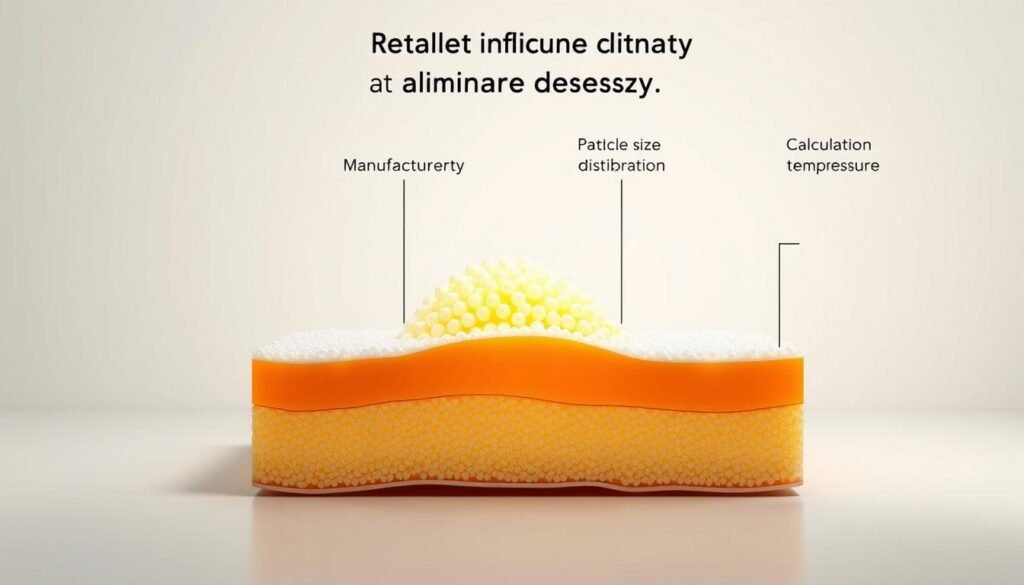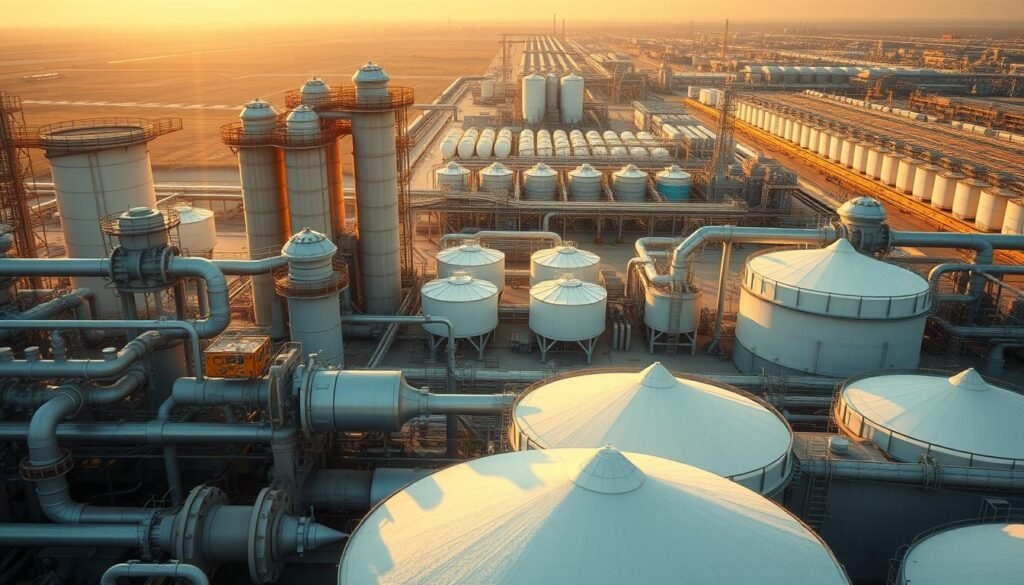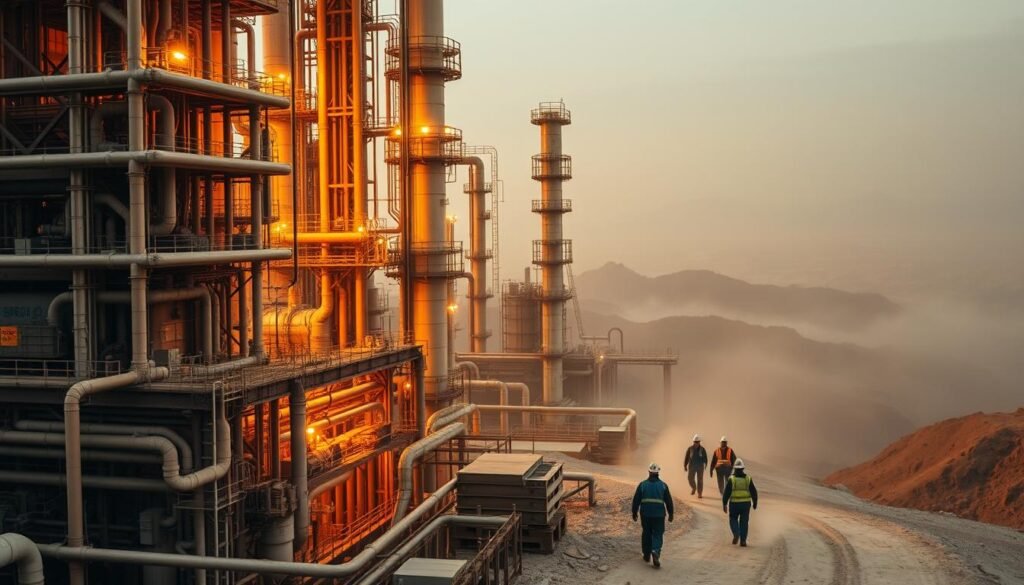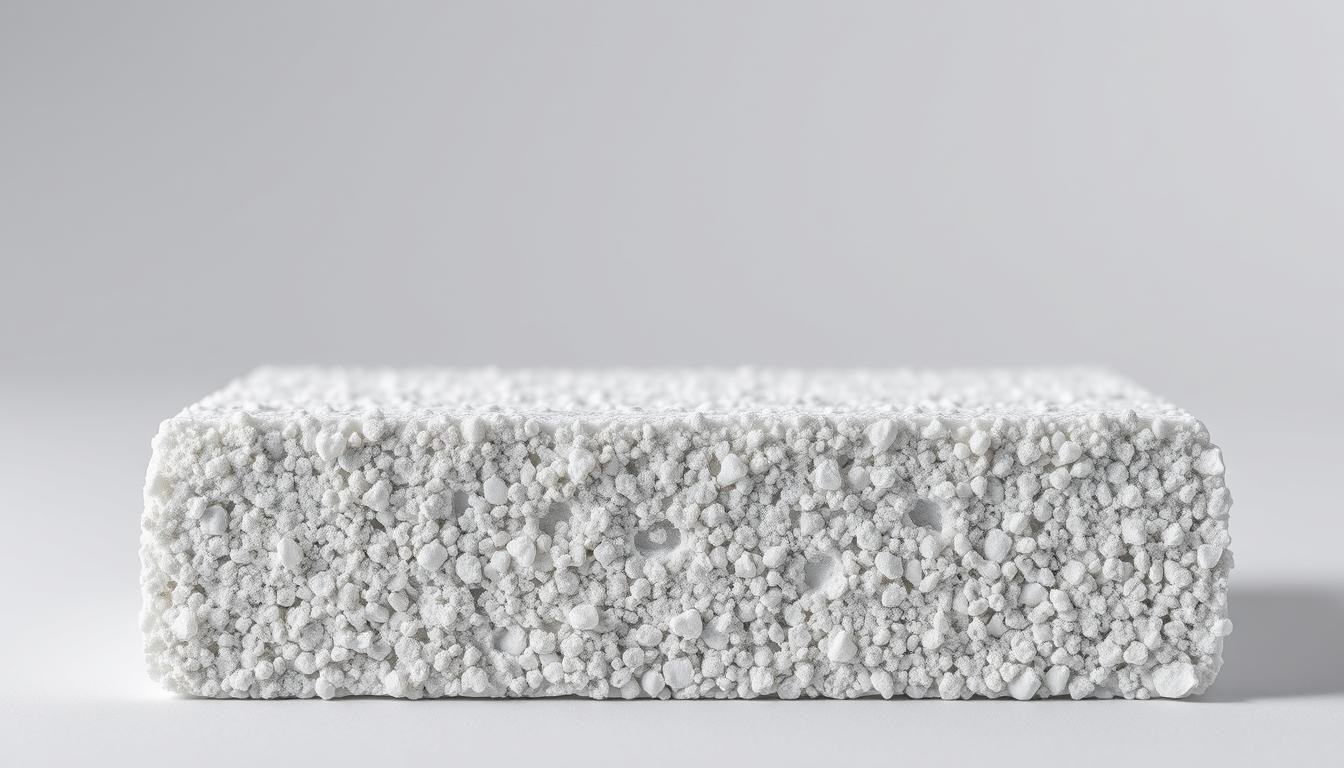Knowing the alumina density, or aluminum oxide (Al₂O₃) density, is key in many fields. It ranges from 3.95 to 4.1 g/cm³, with a precise value of 3.987 g/cm³. Alumina is known for its impressive properties and uses. It’s used in aerospace and electronics, making its density important for material selection.
This article will give you a detailed look at alumina density. It will highlight alumina’s properties and its wide use. For more details, learn about aluminum oxide and its role in today’s technology.
Understanding Alumina: A Fundamental Overview
Alumina, also known as aluminum oxide, is key in many industries. It’s famous for being very hard and stable at high temperatures. Most of it comes from bauxite ore through the Bayer process.
It has many uses. In metalworking, it acts as a strong abrasive. In electronics, it’s used as an insulator. And in ceramics, it’s a vital component.
Knowing about alumina’s basics helps us see its density and uses in different fields. Its chemical stability and strong bonds make it essential. This shows why it’s so important in today’s market.
What is Alumina?
The definition of alumina is aluminum oxide (Al₂O₃). It forms when aluminum and oxygen combine. This material is found naturally as corundum, a key part of sapphires and rubies. Alumina is also a key ingredient in making aluminum metal and its derivatives.
Looking at the alumina composition, we see why it’s so special. Its Mohs hardness of 9 makes it very abrasive. This is why it’s great for grinding and cutting. It also insulates electricity well.
Its high melting point of about 2072°C (3762°F) is another plus. This makes it perfect for use in high-temperature settings. It’s vital for many industrial and technological needs.
Importance of Alumina Density in Various Industries
Alumina density is vital in many fields. It affects how materials behave mechanically, their strength, and how they handle heat. For instance, in aerospace, alumina is vital for heat shields. This ensures safety and efficiency in hot conditions.
In the car industry, alumina’s role is also significant. It helps make cars lighter, which saves fuel without sacrificing safety. This is because of its density.
In electronics, alumina’s properties are unmatched. It offers stability and can withstand extreme conditions. This makes it perfect for insulators and substrates. The medical field also relies on alumina for implants and devices. Its biocompatibility and durability are key benefits.
Alumina’s density is a key factor in its wide use. It allows industries to meet tough performance standards. This shows how versatile and reliable alumina is in critical applications.
Factors Contributing to Alumina Density
Many things affect alumina’s density, which is key to its uses. The structure and the environment play big roles in its density.
Crystalline Structure and Its Effects
The structure of alumina greatly affects its density. Alpha and gamma alumina have different densities because of their atomic arrangements. Alpha alumina is denser because its structure is more stable and packed.
This shows how important the structure is to factors affecting alumina density.
Environmental Factors
The environment also impacts alumina’s density. Temperature and pressure are key during processing. Sintering methods, as explained in the factors affecting alumina density, show how different methods can change density.
Controlling the sintering atmosphere and pressure helps close gaps in the material. This makes it denser.

| Factor | Effect on Density | Notes |
|---|---|---|
| Crystalline Structure | Varies significantly; alpha has higher density than gamma | Stable arrangements yield better density |
| Temperature | Affects molecular mobility; higher temperatures can increase density | Critical during sintering |
| Pressure | Helps in reducing particle gaps | Enhances sintering performance |
| Sintering Atmosphere | Lower oxygen partial pressure aids density improvement | Hydrogen atmospheres effective |
Alumina Density: Key Characteristics and Properties
Alumina density is key to understanding its uses. It has hardness and thermal stability, making it strong. This makes it great for tough environments.
This section talks about how these properties help alumina. It’s useful in many ways, from old to new manufacturing.
Hardness and Thermal Stability
Alumina is very hard, with a rating of 9 on the Mohs scale. This makes it last long and resist wear. It also stays strong at high temperatures.
These traits make it perfect for many uses. It’s good for kiln linings and cutting tools.
Density Values
Alumina’s density values change based on its mix. They usually range from 3.95 to 4.1 g/cm³. For example, 94% alumina is about 3.69 g/cm³, and 99.5% is around 3.89 g/cm³.
These values show alumina’s solid structure. It’s dependable in many fields. For more info, check out Accuratus.
The Production of Alumina and Its Impact on Density
The way alumina is made greatly affects its density. This density is key in many industries. The Bayer process is a main method for making alumina. It involves treating bauxite ore to get alumina.
Knowing how this process works helps us understand how density is affected. Different ways of making alumina can also change its density.
The Bayer Process Explained
The Bayer process has several steps to refine bauxite into alumina. First, bauxite is crushed and ground into a fine powder. Then, it’s mixed with a hot solution of sodium hydroxide.
In the digestion phase, the sodium hydroxide breaks down the aluminum oxide in the bauxite. This leaves behind impurities like iron oxides. Next, the aluminum oxide is made to precipitate out of the solution.
After cooling, the alumina is separated from the solution. The aluminum hydroxide is then heated to remove water. This process makes the desired alumina product. It’s known for its efficiency and high-purity alumina.
Variations in Production Techniques
While the Bayer process is common, other methods can also be used. Techniques like hot pressing and chemical vapor deposition can change alumina’s properties. For example, hot pressing makes alumina denser and stronger by applying high pressure and heat.
Chemical vapor deposition creates alumina films with specific thickness and density. These variations in production affect alumina’s physical properties. They also change how it’s used in industries like aerospace and electronics.

Applications of Alumina Density in Manufacturing
Alumina density is key in many manufacturing areas, like aerospace, electronics, and medical tech. Its light weight and high strength make it perfect for many uses. This shows how versatile and important alumina is in industry.
Uses in Aerospace and Defense
In aerospace, alumina is essential for its ability to handle tough conditions while being light. Its strength helps make planes more fuel-efficient and sturdy. It’s used in turbine blades and missile parts, boosting performance and safety.
Role in Electronics and Medical Technologies
In electronics, alumina is a top choice for circuit boards because of its great dielectric properties. It’s great for making capacitors and insulators, key for devices to work well. In medical tech, its biocompatibility makes it perfect for dental implants and orthopedic devices. This shows how vital alumina is in advancing technology.
Challenges Associated with Alumina Density
Alumina density brings big challenges for makers trying to improve their production. One big problem is that alumina breaks easily under stress. This makes it hard to make parts that need to be strong and last long.
Another big issue is how much energy it takes to make alumina. The process uses a lot of energy, which is bad for the environment and costs a lot. Companies are looking for ways to use less energy without lowering the quality of what they make.
Getting alumina that is very pure is also hard. Pure alumina works better in things like electronics and space tech. But making it pure costs a lot because of the complex steps needed.
Also, making sure the surface of alumina is smooth is tricky. Different densities can make the surface uneven. This affects how well the material works and looks. So, there’s a need for new ways to solve these problems.

Alumina Density: Comparative Analysis with Other Materials
When we compare alumina, we see it outshines materials like silicon oxide and titanium oxide. It has better hardness and thermal stability. These traits are key for industries needing materials that can handle tough conditions.
Looking at everyday use, alumina shines. It has a hardness of 9 on the Mohs scale, one of the highest. Silicon oxide rates around 7, and titanium oxide is a bit lower. This high hardness makes alumina great for cutting tools and coatings.
Alumina also excels in thermal stability. While silicon oxide degrades at high temperatures, alumina stays strong. This makes it perfect for aerospace and automotive needs. Here’s a table showing how these materials compare:
| Material | Hardness (Mohs Scale) | Thermal Stability (°C) | Common Applications |
|---|---|---|---|
| Alumina | 9 | 2000 | Cutting tools, electronics |
| Silicon Oxide | 7 | 1600 | Insulators, glass production |
| Titanium Oxide | 6-7 | 1000 | Coatings, pigments |
Alumina’s performance shows it’s a top choice over traditional materials. Knowing these differences helps industries pick the right material. This is important for durability and heat resistance.
Conclusion
This article talks about the importance of alumina density in many fields. Alumina is known for its hardness, thermal stability, and versatility. These qualities make it very useful in today’s technology.
Alumina density is key in making things like airplanes and electronic devices. It helps in making these products better and more efficient. This is thanks to its unique properties.
New ways of making alumina, like the Bayer process, are changing how it’s used. These new methods will make making alumina faster and better. This will help it be used in even more areas.
As technology gets better, so will the demand for materials like alumina. It will keep playing a big role in making new things. This is because it’s so good at what it does.
There’s also a big push for making things more sustainable and efficient. This will make alumina even more important. It shows how vital alumina is for making advanced products.
